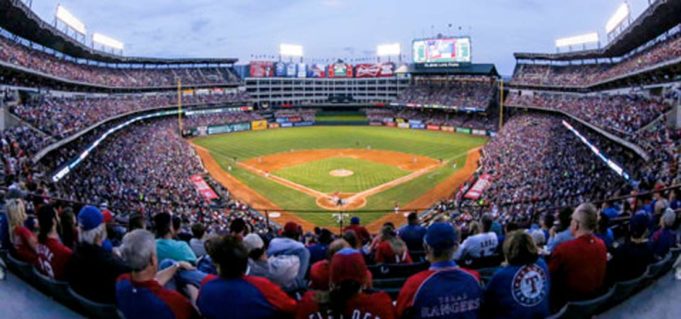Back in 1994, Arlington leaders were calling the newly built Ballpark in Arlington the greatest thing since the Greek Parthenon. Tom Scheiffer said Texas Rangers fans would enjoy the structure for 100 years. Schieffer was part of the George W. Bush-led investment group that purchased the team in 1989. Plenty of flesh-pressing and arm-twisting later, the future Texas governor and U.S. president convinced city leaders and voters to put up public funding for the $191 million stadium that Bush would describe as an artistic “monument to baseball.”
Bush, a former oilman, was never keen on global warming and science-y stuff, and he didn’t anticipate the public’s growing obesity problem. Now, a mere 22 years later, the Ballpark is obsolete because fans are so well insulated by blubber in this age of rising temperatures that we need refrigerated air or we will die of strokes while clutching at our artery-clogged hearts with fingers covered in nacho cheese. Bush’s monument to baseball has become a deathtrap and an embarrassment to team officials, who want to replace it with a new stadium that boasts a retractable roof to keep all that cold air from escaping into our apocalyptic atmosphere.
In November, Arlington voters will decide whether to fork over $500 million in public funding to pay for half of the cost. Team owners will pay the other $500-mill. Arlington Mayor Jeff Williams is head cheerleader, citing –– as city leaders almost always do –– the huge economic impact that new stadiums bring to cities and surrounding areas. Plenty of studies paint the opposite picture. Lofty predictions of financial windfalls are as bogus as the concrete longhorns on the Ballpark façade. Or, as Temple University sports economist Michael Leeds told a public radio host in California last year, “If you ever had a consensus in economics, this would be it –– there is no impact.”
A baseball team playing 80 home games a year has about the same impact on a community as a midsize department store, Leeds said. He and other economists say new stadiums prompt little new spending since the dollars spent there would have been spent somewhere else in the city, such as at small businesses. Meanwhile, the associated traffic congestion can even frighten people away from the area.
The last time a sports owner wanted Arlington taxpayers to split construction costs, the naysayers screamed bloody murder. That was in the early 2000s when Jerry Jones wanted taxpayers to pay hundreds of millions of dollars for a new home for his Cowboys. Dallas officials said no way. Arlington voters who had embraced the Ballpark by a 2-to-1 margin seemed less inclined to give billionaire Jones a handout to build a stadium for one of the most profitable sports teams in the world. Critics pointed to The Ballpark in Arlington: An Economic Impact Study. In his 2000 master’s thesis at UNT, Joel A. Smith disputed claims that the Ballpark improved the local economy, writing that the “study found no significant increase in sales tax receipts for Arlington during the baseball season.”
Residents eventually bought into Jones’ dream. In 2004, they voted to pay $325 million of the stadium that ended up costing $1 billion to build.
We couldn’t track down Smith but found a couple of former UNT profs –– Terry Clower and Bud Weinstein –– who were involved in the study. Neither seemed surprised about plans to replace the Ballpark. Both seemed pretty Zen about the whole thing.
Clower was a professor and advisor at UNT when Smith’s report came out and is currently the professor of public policy at George Mason University in Arlington, Va. Living up North, he was under the impression that locals back in Arlington, Texas, still loved their Ballpark, currently named Globe Life Park. “I wasn’t aware until this came up that the team had decided it wasn’t the amenity they needed anymore, that they needed climate control,” he said.
Clower recalled hot afternoons sitting behind the third base line at the Ballpark. “You are just toasting,” he said.
He recalled in 1965 when the Houston Astrodome was considered the eighth wonder of the world. Forty years later, it was run down, out of code, and obsolete. Rangers officials are being proactive, Clower declared.
“The stated purpose is they feel they can improve attendance by having a more pleasant experience for the fans,” he said. “It may well be true.”
From his time in the D.C. area, he noted that Washington Redskins Owner Daniel Snyder wants a new stadium as well. Snyder’s Redskins play at FedEx Field, which opened in 1997, making it only 19 years old.
Weinstein was a UNT department chairperson when Smith released his study and is now associate director of the Maguire Energy Institute at SMU. His philosophy about stadiums is pretty simple.
“If the public is willing to pay for it, that’s fine,” he said.
Numerous studies show that stadium costs exceed the measured benefits, he said, despite what team owners and city officials claim. On the other hand, he said, the unmeasured benefits are often overlooked.
“How do the citizens feel about it?” he said. “If they think it is nice to have a covered stadium for their home team and they want to subsidize it, it’s fine.”
Stadiums shouldn’t be looked at solely as economic investments, anyway, he said.
“You have to consider the intangible benefits” such as visibility, name recognition, television coverage, prestige, pride, and a sense of community, he said.
“I can’t assign a dollar benefit to that, but it is clearly worth something,” Weinstein said.
What is the value of being cool in August? Weinstein attends Astros games at Minute Maid Park when he is in Houston. Minute Maid opened in 2000, replacing the eighth wonder of the world.
“It’s real nice being in the air conditioning watching the game,” Weinstein said.
So what should Arlington do?
Clower knows.
“Respect the ballot box,” he said.












